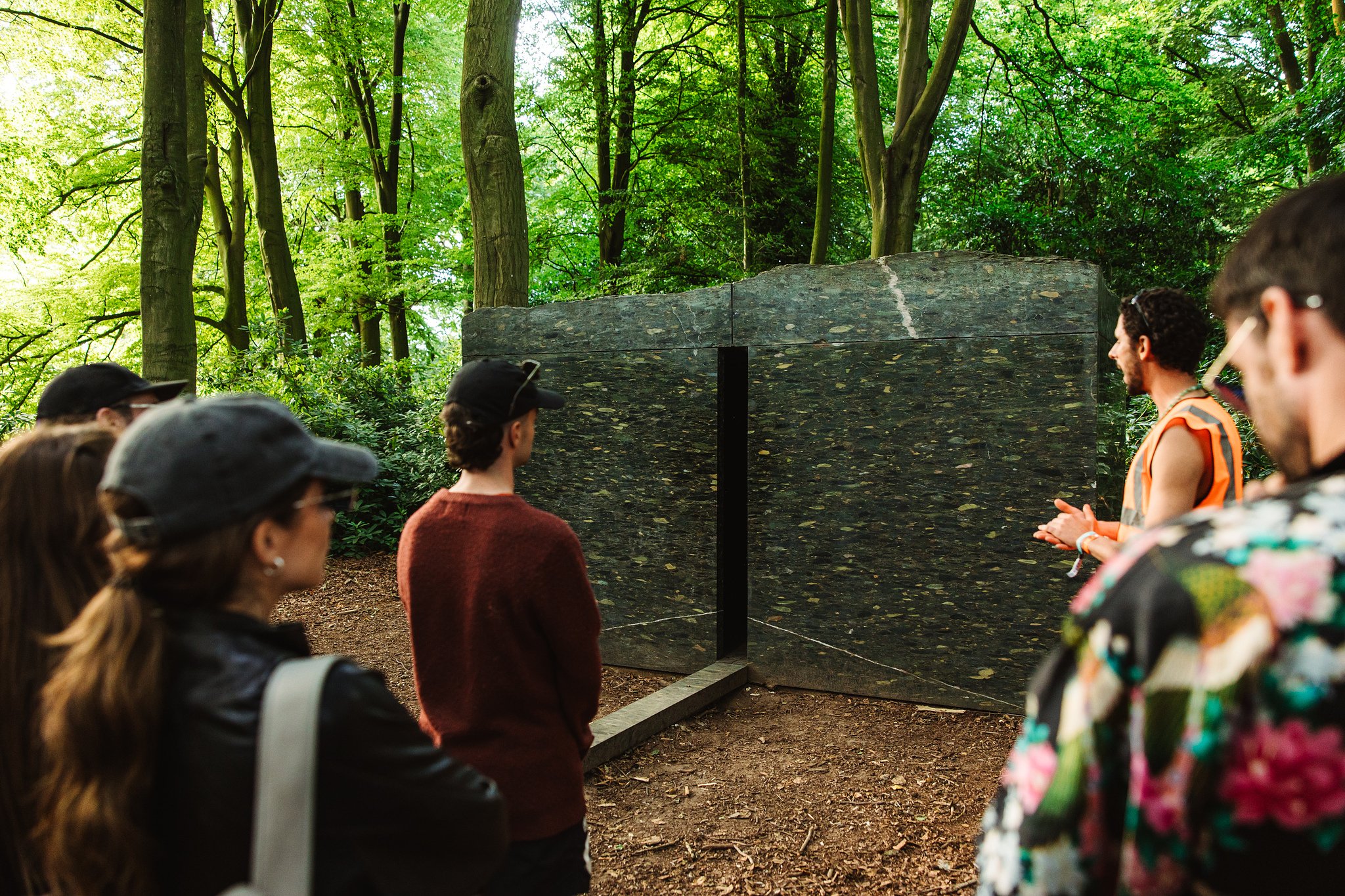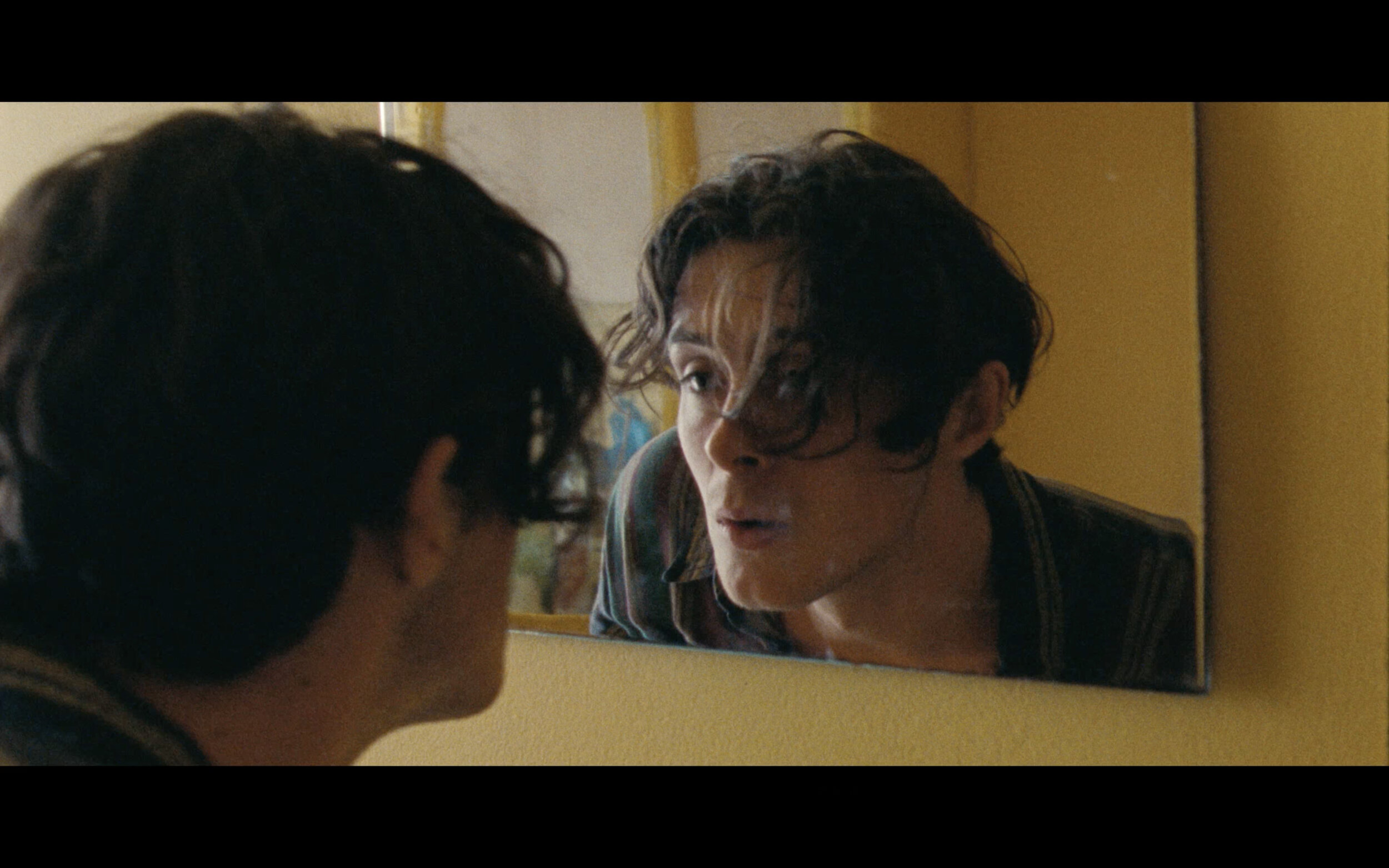Tantrum Stage
text by Lara Monro
photographs by Khroma Collective
Since the 2000s, Houghton Hall, an expansive Georgian residence built in the 1720s for Britain’s first Prime Minister, Sir Robert Walpole, has gained international renown as a world-class sculpture park, featuring permanent works by Richard Long, Ryan Gander, Rachel Whiteread, and James Turrell, to name a few.
The Hall’s sculpture park is further accompanied by an annual solo exhibition program showcasing esteemed artists such as Damien Hirst and Anish Kapoor. This year, Sir Antony Gormley’s Time Horizon places 100 sculptures across 300 acres, with Dame Magdalene Odundo’s artworks simultaneously positioned within the state rooms.
Stephen Cox “Interior Space”
copyright Houghton Hall
In 2017, Houghton Hall complemented its art collection by adding Houghton Festival, the underground dance music festival established, crafted and curated by Craig Richards. It instantly earned acclaim for its five-star lineup, sound systems, lighting, and reputation as a hedonistic playground (thanks to its rare 24-hour license), with Mixmag hailing it as “a festival the UK is lucky to have” and The Independent calling it a “utopian retreat like no other.” As a result, each August, discerning music enthusiasts of all ages, nationalities, and backgrounds converge to immerse themselves in a musical Valhalla that knows no pause.
However, Houghton is so much more than just a musical odyssey. The festival and its music stages, impressive as standalone sonic and visual installations, also coincide with a rich visual arts program that is integral to the Houghton experience. For Richards, the intention behind the 24-hour festival is not merely to host a round-the-clock party, but to create a space where the interplay of sound, art and the shifts of dawn, dusk and all things nature can be profoundly appreciated. He explains, “it’s about the beauty of sunrise and sunset, experimentation, and savoring the festival’s diverse offerings at any hour of the day or night."
Now fifty-seven, Richards reflects on his impressive career as a DJ, which he describes as accidental. After spending a year in Los Angeles at nineteen years old, where he immersed himself in the vibrant Downtown LA music scene at iconic parties like Dirt Box and Power Tools, he moved to London in 1987 to study illustration at Central Saint Martins and went on to an MA at the Royal College of Art.
“It was during my time in the States I bought a lot of records. I had always collected soul, funk, disco, and reggae records from before I moved to London.” During his time at Saint Martins there was a coffee bar at the Charing Cross Road building—incidentally, the first place the Sex Pistols ever played. “Naturally, it was the perfect spot to organize parties, as was Soho, where it was easy to acquire a hundred-person basement for the night to have a party, Soho was a very different place then. Before long, I was getting paid to DJ instead of just earning a taxi fare home, and that was it, really.” Richards’ ‘accidental’ career quickly gained momentum, establishing him as a key figure in the global music scene. Yet, even as his sonic reputation flourished, he remained committed to creative pursuits beyond the decks, with a deep engagement in painting, drawing, photography, and silkscreen printing.
Craig Richards "Untitled"
This dual commitment to both music and visual arts has become a defining characteristic of Houghton. Blending auditory and visual experiences, the festival has become Richards’ canvas, allowing him to explore his artistic creativity in dynamic and innovative ways. His imprint is everywhere, from the festival’s poster designs that feature his original artwork, to a number of visual installations at a selection of the music stages, to the lineup penned in his unmistakable handwriting.
But the creativity doesn’t stop there. Richards has also commissioned a series of site-specific installations over the past eight years. Large, steel sculptural pieces have been created from his drawings, none more poignant than the 8-meter-tall sculpture dedicated to the late Andrew Weatherall. This iron structure, birthed from a series of sketches Richards created in 2017, stands proudly at the festival’s epicenter, paying homage to Weatherall’s immense talent and influence in the contemporary music world;
Craig Richards "Andrew"
“Andrew was one of the first people who inspired me to become a DJ,” Richards reflects. “Everything he did, from Sonic Blood Sugar to his presence at gigs, left a mark. Many of us in this industry find ourselves asking, ‘What would Andrew do?’ It’s a tragedy that the captain of our ship was taken from us. The sculpture’s grandeur reflects his lasting impact and the fact that he will always be a part of this festival and the music scene.”
For Richards, this sculpture embodies the depth and breadth of Houghton’s offerings, which he is proud to have extended far beyond music. Its diverse program includes talks and installations that truly enrich the experience. The Armadillo, a timber arts pavilion commissioned for Houghton 2024 in partnership with the architectural firm Unknown Works, hosted an array of talks and performances such as London based DJ Anna Wall’s ambient music set. The Pinter stage, nestled amongst an idyllic orchard, was graced by Swiss pianist and composer Nik Bärtsch who shared a mind-sound and soul-altering performance while American beatboxer, comedian and musician Reggie Watts, performed a light-hearted yet exceptionally crafted sketch, perfect for a Sunday afternoon and slightly tired and tender festival crowd. The Warehouse, a repurposed barn, was transformed into a digital art space by UVA who showcased Present Shock II, a mind-bending installation created in collaboration with Robert Del Naja. Deep within the forest, Natural Symphony’s interactive festival forest design; a sound and light installation that uses the natural biorhythms of plants to create music and visuals, offered a moment of wonder, grounding and tranquility. Meanwhile, a quaint ‘noddy train,’ accompanied by art historians, would transport the more adventurous to James Turrell’s Skyspace, an immersive sculpture positioned in an elevated oak box that encourages visitors to sit at dusk or dawn and enjoy the Norfolk sky cycles of blues and purples.
While Houghton has evolved into a celebrated festival, its journey has been anything but linear. The festival has managed to face and overcome significant setbacks, including a last-minute cancellation in 2019 due to extreme weather and two subsequent years lost to the pandemic. That it has endured without government or commercial funding is a testament to its resilience and the strong community it fosters. For Richards, the pursuit of something meaningful far outweighs the lure of profit. “When you prioritize significance over financial gain, creativity naturally flourishes,” he explains. Richards’ determination and perseverance may also be attributed to his enduring optimism, a quality he credits to his parents and their appreciation for the art of presentation; “my parents were both cabin crew in the 1950s, they instilled in me a deep understanding of how to do things properly—how to create an experience,” Richards reflects. “They were products of a pivotal era, epitomized by events like the 1951 Festival of Britain, which celebrated art and embodied a spirit of optimism. This outlook has profoundly shaped me; I’ve inherited their belief in making things as exceptional as possible, and it continues to drive me forward.”
Richards’ meticulous attention to detail, coupled with his passion and craftsmanship, are clearly influenced by this familial legacy of hard work and dedication. And, Houghton’s authenticity is undeniably an extension of this. Although Richards acknowledges that the visual arts program has yet to reach the level of its musical counterpart, his optimism assures him that it is only a matter of time. “With patience, I am confident this will be achieved,” he says. “It will happen organically as we gradually build a bigger community—a group of believers who share in this vision.”
Reggie Watts at Pinters Stage




















